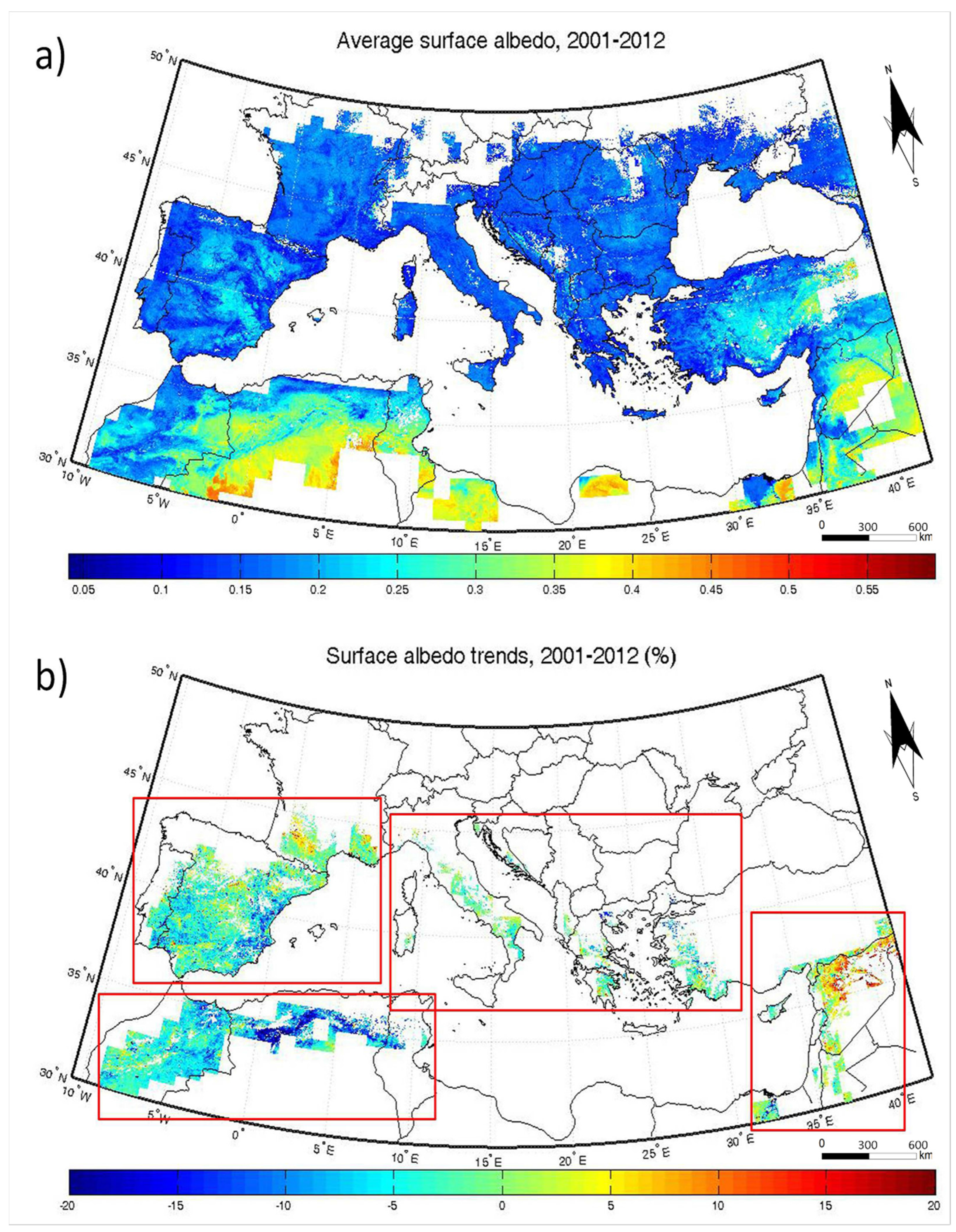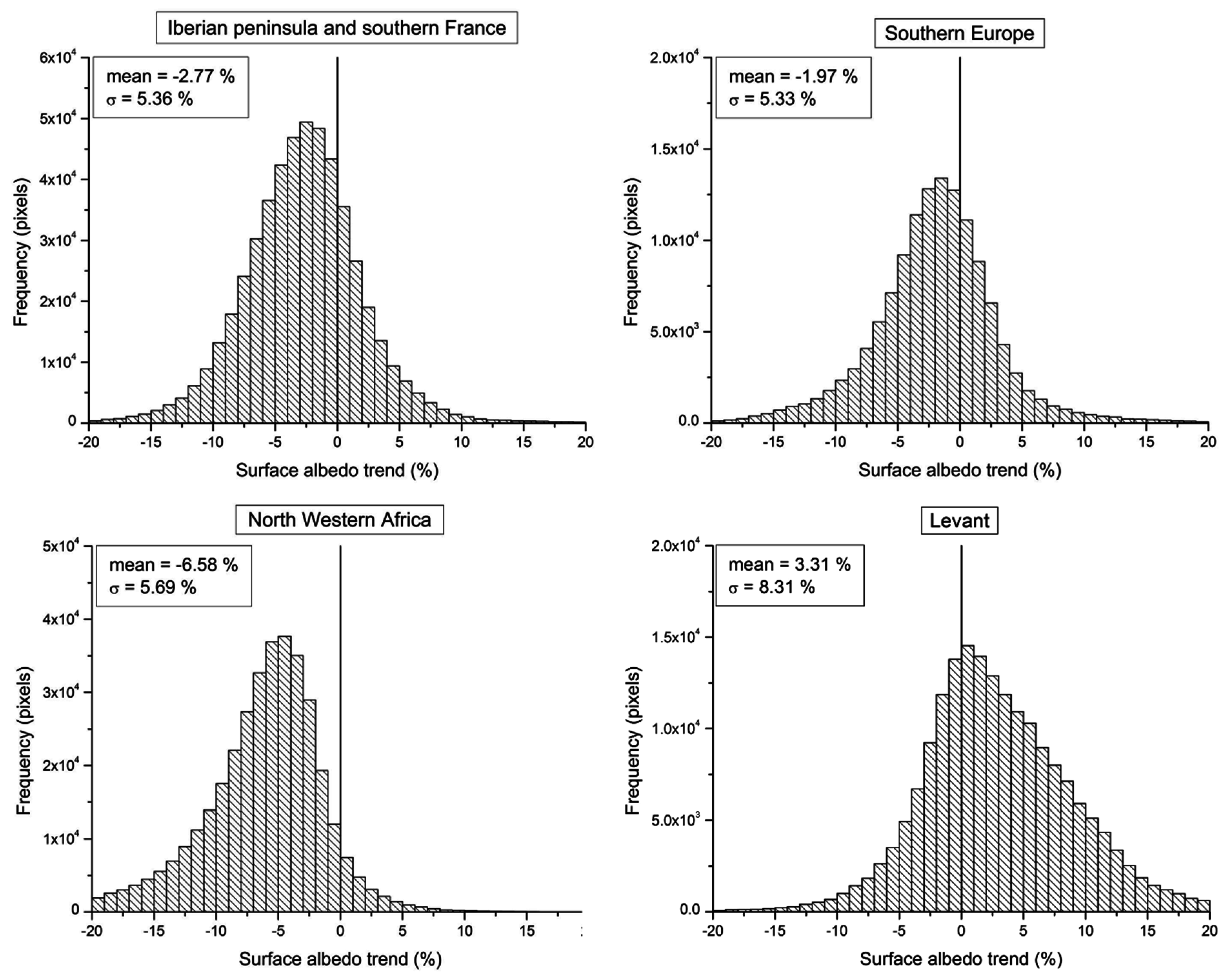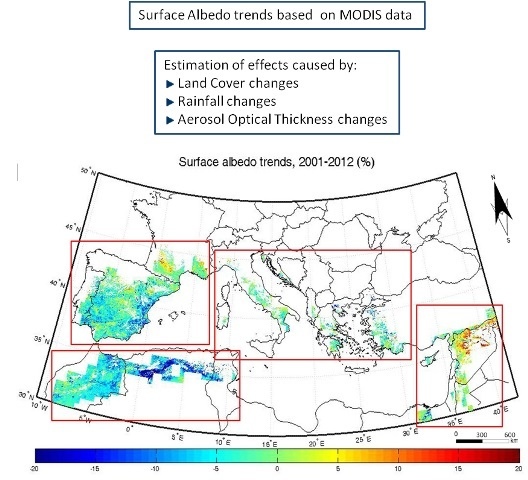Estimation of the Land Surface Albedo Changes in the Broader Mediterranean Area, Based on 12 Years of Satellite Observations
Abstract
:1. Introduction
2. Data and Methodology
2.1. Surface Albedo Estimation
2.2. Estimation of the Annual Average Surface Albedo
2.3. Estimation of Surface Albedo Changes
3. Results
3.1. Average Surface Albedo and Changes


3.2. Land Cover Change Effects on Surface Albedo
| LC Code | Land Cover Type | Coverage in 2000 (%) | Coverage in 2010 (%) | LSA (Mean ± 1σ) |
|---|---|---|---|---|
| 10 | Cropland, rainfed | 38.35 | 38.38 | 0.17 ± 0.03 |
| 20 | Cropland, irrigated or post-flooding | 2.46 | 2.46 | 0.19 ± 0.04 |
| 30 | Mosaic cropland (>50%)/natural vegetation | 0.85 | 0.86 | 0.16 ± 0.03 |
| 40 | Mosaic natural vegetation (>50%) | 1.92 | 1.95 | 0.16 ± 0.03 |
| 50 | Tree cover, broadleaved, evergreen, closed to open (>15%) | 0.02 | 0.02 | 0.13 ± 0.01 |
| 60 | Tree cover, broadleaved, deciduous, closed to open (>15%) | 9.34 | 9.31 | 0.15 ± 0.02 |
| 70 | Tree cover, needleleaved, evergreen, closed to open (>15%) | 4.59 | 4.54 | 0.13 ± 0.02 |
| 80 | Tree cover, needleleaved, deciduous, closed to open (>15%) | <0.01 | <0.01 | 0.14 ± 0.03 |
| 90 | Tree cover, mixed leaf type | 1.91 | 1.90 | 0.13 ± 0.02 |
| 100 | Mosaic tree and shrub (>50%) | 2.54 | 2.54 | 0.14 ± 0.03 |
| 110 | Mosaic herbaceous cover (>50%) | 0.03 | 0.03 | 0.20 ± 0.07 |
| 120 | Shrubland | 2.11 | 2.11 | 0.15 ± 0.04 |
| 130 | Grassland | 4.05 | 4.06 | 0.19 ± 0.04 |
| 140 | Lichens and mosses | 0.00 | 0.00 | - |
| 150 | Sparse vegetation | 6.58 | 6.58 | 0.24 ± 0.06 |
| 160 | Tree cover, flooded, fresh or brackish water | 0.00 | 0.00 | - |
| 170 | Tree cover, flooded, saline water | <0.01 | <0.01 | 0.18 ± 0.04 |
| 180 | Shrub or herbaceous cover, flooded | 0.29 | 0.29 | 0.14 ± 0.04 |
| 190 | Urban areas | 3.92 | 3.92 | 0.17 ± 0.03 |
| 200 | Bare areas | 20.96 | 20.96 | 0.33 ± 0.06 |
| Land Cover in 2000 | Land Cover in 2010 | % LSA Change (Mean ± 1σ) |
|---|---|---|
| Tree cover, needleleaved, evergreen, closed to open (>15%) | Cropland, rainfed | 14.27 ± 12.56 |
| Mosaic cropland (>50%)/natural vegetation | 13.09 ± 6.55 | |
| Mosaic natural vegetation (>50%) | 14.10 ± 16.29 | |
| Shrubland | 12.62 ± 10.74 |
3.3. Rainfall Change Effects on Surface Albedo

3.4. AOT Change Effects on Surface Albedo

4. Conclusions
Acknowledgments
Author Contributions
Conflicts of Interest
References
- Schaepman-Strub, G.; Schaepman, M.E.; Painter, T.H.; Dangel, S.; Martonchik, J.V. Reflectance quantities in optical remote sensing-definitions and case studies. Remote Sens. Environ. 2006, 103, 27–42. [Google Scholar] [CrossRef]
- Vardavas, I.M.; Taylor, F.W. Radiation and Climate: Atmospheric Energy Budge from Satellite Remote Sensing; Oxford University Press: Oxford, UK, 2011. [Google Scholar]
- Shuai, Y.; Masek, J.G.; Gao, F.; Schaaf, C.B. An algorithm for the retrieval of 30-m snow-free albedo from Landsat surface reflectance and MODIS BRDF. Remote Sens. Environ. 2011, 115, 2204–2216. [Google Scholar] [CrossRef]
- Schaaf, C.B.; Martonchik, J.; Pinty, B.; Govaerts, Y.; Gao, F.; Lattanzio, A.; Liu, J.; Strahler, A.; Taberner, M. Retrieval of surface albedo from satellite sensors. In Advances in Land Remote Sensing: System, Modeling, Inversion and Application; Liang, S., Ed.; Springer: Houten, The Netherlands, 2008; pp. 219–243. [Google Scholar]
- Trenberth, K.E.; Jones, P.D; Ambenje, P.; Bojariu, R.; Easterling, D.; Tank, A.K.; Parker, D.; Rahimzadeh, F.; Renwick, J.A.; Rusticucci, M.; et al. Observations: Surface and atmospheric climate change. In Climate Change 2007: The Physical Science Basis. Contribution of Working Group I to the Fourth Assessment Report of the Intergovernmental Panel on Climate Change; Solomon, S., Qin, D., Manning, M., Chen, Z., Marquis, M., Averyt, K.B., Tignor, M., Miller, H.L., Eds.; Cambridge University Press: Cambridge, UK; New York, NY, USA, 2007. [Google Scholar]
- Trenberth, K.E. Changes in precipitation with climate change. Clim. Res. 2011, 47, 123–138. [Google Scholar] [CrossRef]
- IPCC. Managing the Risks of Extreme Events and Disasters to Advance Climate Change Adaptation; A Special Report of Working Groups I and II of the Intergovernmental Panel on Climate Change; Field, C.B., Barros, V., Stocker, T.F., Qin, D., Dokken, D.J., Ebi, K.L., Mastrandrea, M.D., Mach, K.J., Plattner, G.K., Allen, S.K., et al., Eds.; Cambridge University Press: Cambridge, UK; New York, NY, USA, 2012. [Google Scholar]
- Román, M.O.; Schaaf, C.B.; Lewis, P.; Gao, F.; Anderson, G.P.; Privette, J.L.; Strahler, A.H.; Woodcock, C.E.; Barnsley, M. Assessing the coupling between surface albedo derived from MODIS and the fraction of diffuse skylight over spatially-characterized landscapes. Remote Sens. Environ. 2010, 114, 738–760. [Google Scholar] [CrossRef]
- Sutterlin, M.; Schaaf, C.B.; Stockli, R.; Sun, Q.; Husler, F.; Neuhaus, C.; Wunderle, S. Albedo and reflectance anisotropy retrieval from AVHRR operated onboard NOAA and MetOp satellites: Algorithm performance and accuracy assessment for Europe. Remote Sens. Environ. 2015, 168, 163–176. [Google Scholar] [CrossRef]
- Schaaf, C.; Gao, F.; Strahler, A.; Lucht, W.; Li, X.; Tsung, T.; Strugnell, N.; Zhang, X.; Jin, Y.; Muller, J.P.; et al. First operational BRDF, albedo and nadir reflectance products from MODIS. Remote Sens. Environ. 2002, 83, 135–148. [Google Scholar] [CrossRef]
- Román, M.O.; Schaaf, C.B.; Woodcock, C.E.; Strahler, A.H.; Yang, X.; Braswell, R.H.; Curtis, P.S.; Davis, K.J.; Dragoni, D.; Goulden, M.L.; et al. The MODIS (Collection V005) BRDF/albedo product: Assessment of spatial representativeness over forested landscapes. Remote Sens. Environ. 2009, 113, 2476–2498. [Google Scholar] [CrossRef]
- Liu, J.; Schaaf, C.; Strahler, A.; Jiao, Z.; Shuai, Y.; Zhang, Q.; Roman, M.; Augustine, J.A.; Dutton, E.G. Validation of Moderate Resolution Imaging Spectroradiometer (MODIS) albedo retrieval algorithm: Dependence of albedo on solar zenith angle. J. Geophys. Res. 2009, 114, D01106. [Google Scholar] [CrossRef]
- Cescatti, A.; Marcolla, B.; Santhana Vannan, S.K.; Pan, J.Y.; Román, M.O.; Yang, X.; Ciais, P.; Cook, R.B.; Law, B.E.; Matteucci, G.; et al. Intercomparison of MODIS albedo retrievals and in situ measurements across the global FLUXNET network. Remote Sens. Environ. 2012, 121, 323–334. [Google Scholar] [CrossRef]
- Lucht, W.; Schaaf, C.B.; Strahler, A.H. An algorithm for the retrieval of albedo from space using semi empirical BRDF models. IEEE Trans. Geosci. Remote Sens. 2000, 38, 977–998. [Google Scholar] [CrossRef]
- Levy, R.C.; Remer, L.A.; Kleidman, R.G.; Mattoo, S.; Ichoku, C.; Kahn, R.; Eck, T.F. Global evaluation of the Collection 5 MODIS dark-target aerosol products over land. Atmos. Chem. Phys. 2010, 10, 10399–10420. [Google Scholar] [CrossRef] [Green Version]
- Benas, N.; Chrysoulakis, N. Estimation of land surface albedo time series and trends based on MODIS data. In Proceedings of the SPIE 9239, Remote Sensing for Agriculture, Ecosystems, and Hydrology XVI, 92390Q, Amsterdam, The Netherlands, 22 September 2014.
- Musial, J.P.; Verstraete, M.M.; Gobron, N. Technical Note: Comparing the effectiveness of recent algorithms to fill and smooth incomplete and noisy time series. Atmos. Chem. Phys. 2011, 11, 7905–7923. [Google Scholar] [CrossRef] [Green Version]
- Hollmann, R.; Merchant, C.; Saunders, R.; Downy, C.; Buchwitz, M.; Cazenave, A.; Chuvieco, E.; Defourny, P.; de Leeuw, G.; Forsberg, R.; et al. The ESA climate change initiative: Satellite data records for essential climate variables. B. Am. Meteorol. Soc. 2013, 94, 1541–1552. [Google Scholar] [CrossRef]
- Bontemps, S.; Defourny, P.; Brockmann, C.; Herold, M.; Kalogirou, V.; Arino, O. New global land cover mapping exercise in the framework of the ESA Climate Change Initiative. In Proceedings of the IEEE International Geoscience and Remote Sensing Symposium (IGARSS), Munich, Germany, 22–27 July 2012; pp. 44–47.
- Bontemps, S.; Herold, M.; Kooistra, L.; van Groenestijn, A.; Hartley, A.; Arino, O.; Moreau, I.; Defourny, P. Revisiting land cover observation to address the needs of the climate modeling community. Biogeosciences 2012, 9, 2145–2157. [Google Scholar] [CrossRef] [Green Version]
- Liu, S.; Roujean, J.L.; Tchuente, A.T.K.; Ceamanos, X.; Calvet, J.C. A parameterization of SEVIRI and MODIS daily surface albedo with soil moisture: Calibration and validation over southwestern France. Remote Sens. Environ. 2014, 144, 137–151. [Google Scholar] [CrossRef]
- Kummerow, C.; Simpson, J.; Thiele, O.; Barnes, W.; Chang, A.T.C.; Stocker, E.; Adler, R.F.; Hou, A.; Kakar, R.; Wentz, F.; et al. The status of the tropical rainfall measuring mission (TRMM) after two years in Orbit. J. Appl. Meteorol. 2000, 39, 1965–1982. [Google Scholar] [CrossRef]
- Feidas, H. Validation of satellite rainfall products over Greece. Theor. Appl. Climatol. 2010, 99, 193–216. [Google Scholar] [CrossRef]
- Gabella, M.; Michaelides, S.; Constantinides, P.; Perona, G. Climatological validation of TRMM precipitation radar monthly rain products over Cyprus during the first 5 years. Meteorol. Z. 2006, 15, 559–564. [Google Scholar] [CrossRef]
- Levy, R.; Remer, L.; Tanré, D.; Mattoo, S.; Kaufman, Y. Algorithm for Remote Sensing of Tropospheric Aerosol over Dark Targets from MODIS: Collections 005 and 051: Revision 2; Feb 2009; NASA/GSFC: Greenbelt, MD, USA, 2009. [Google Scholar]
- He, T.; Liang, S.; Song, D.X. Analysis of global land surface albedo climatology and spatial-temporal variation during 1981–2010 from multiple satellite products. J. Geophys. Res. Atmos. 2014, 119, 10281–10298. [Google Scholar] [CrossRef]
- Liang, S.; Zhao, X.; Liu, S.; Yuan, W.; Cheng, X.; Xiao, Z.; Zhang, X.; Liu, Q.; Cheng, J.; Tang, H.; et al. A long term Global Land Surface Satellite (GLASS) data-set for environmental studies. Int. J. Digital Earth 2013, 6, 5–33. [Google Scholar] [CrossRef]
- Dorigo, W.; de Jeu, R.; Chung, D.; Parinussa, R.; Liu, Y.; Wagner, W.; Fernandez-Prieto, D. Evaluating global trends (1988–2010) in harmonized multi-satellite surface soil moisture. Geophys. Res. Lett. 2012, 39, L18405. [Google Scholar] [CrossRef]
- Lyapustin, A.; Wang, Y.; Xiong, X.; Meister, G.; Platnick, S.; Levy, R.; Franz, B.; Korkin, S.; Hilker, T.; Tucker, J.; et al. Scientific impact of MODIS C5 calibration degradation and C6+ improvements. Atmos. Meas. Tech. 2014, 7, 4353–4365. [Google Scholar] [CrossRef]
- Dummont, M.; Brun, E.; Picard, G.; Michou, M.; Libois, Q.; Petit, J.R.; Geyer, M.; Morin, S.; Josse, B. Contribution of light-absorbing impurities in snow to Greenland’s darkening since 2009. Nat. Geosci. 2014, 7, 509–512. [Google Scholar] [CrossRef]
- Stroeve, J.; Box, J.E.; Wang, Z.; Schaaf, C.; Barrett, A. Re-evaluation of MODIS MCD43 Greenland albedo accuracy and trends. Remote Sens. Environ. 2013, 138, 199–214. [Google Scholar] [CrossRef]
- Box, J.E.; Fettweis, X.; Stroeve, J.; Tedesco, M.; Hall, D.K.; Steffen, K. Greenland ice sheet albedo feedback: Thermodynamics and atmospheric drivers. Cryosphere 2012, 6, 821–839. [Google Scholar] [CrossRef]
- Polashenski, C.M.; Dibb, J.E.; Flanner, M.G.; Chen, J.Y.; Courville, Z.R.; Lai, A.M.; Schauer, J.J.; Shafer, M.M.; Bergin, M. Neither dust nor black carbon causing apparent albedo decline in Greenland’s dry snow zone: Implications for MODIS C5 surface reflectance. Geophys. Res. Lett. 2015, 42. [Google Scholar] [CrossRef]
- Benas, N.; Chrysoulakis, N.; Christakis, N.; Kossioris, G.; Plexousakis, M. WRF input parameter updates based on recent and long-term satellite observations. In Proceedings of the 12th International Conference of Meteorology, Climatology and Physics of the Atmosphere (COMECAP 2014), 28–31 May 2014; pp. 127–131.
- Boschetti, L.; Roy, D.; Barbosa, P.; Boca, R.; Justice, C. A MODIS assessment of the summer 2007 extent burned in Greece. Int. J. Remote Sens. 2008, 29, 2433–2436. [Google Scholar] [CrossRef]
- Liberato, M.R.L.; Pinto, J.G.; Trigo, I.F.; Trigo, R.M. Klaus—An exceptional winter storm over northern Iberia and southern France. Weather 2011, 66, 330–334. [Google Scholar] [CrossRef]
- Papadimas, C.D.; Hatzianastassiou, N.; Mihalopoulos, N.; Querol, X.; Vardavas, I. Spatial and temporal variability in aerosol properties over the Mediterranean basin based on 6-year (2000–2006) MODIS data. J. Geophys. Res. 2008, 113, D11205. [Google Scholar] [CrossRef]
- De Meij, A.; Pozzer, A.; Lelieveld, J. Trend analysis in aerosol optical depths and pollutant emission estimates between 2000 and 2009. Atmos. Environ. 2012, 51, 75–85. [Google Scholar] [CrossRef]
- Lewis, P.; Barnsley, M.J. Influence of the sky radiance distribution on various formulations of the earth surface albedo. In Proceedings of the Conf. Physics Measures and Signals, Val d’Isere, France, 17–21 January 1994; pp. 707–715.
- Lyapustin, A.; Wang, Y.; Laszlo, I.; Kahn, R.; Korkin, S.; Remer, L.; Levy, R.; Reid, J.S. Multiangle implementation of atmospheric correction (MAIAC): 2. Aerosol algorithm. J. Geophys. Res. 2011, 116, D03211. [Google Scholar] [CrossRef]
- Benas, N.; Chrysoulakis, N.; Giannakopoulou, G. Validation of MERIS/AATSR synergy algorithm for aerosol retrieval against globally distributed AERONET observations and comparison with MODIS aerosol product. Atmos. Res. 2013, 132, 102–113. [Google Scholar] [CrossRef]
© 2015 by the authors; licensee MDPI, Basel, Switzerland. This article is an open access article distributed under the terms and conditions of the Creative Commons by Attribution (CC-BY) license (http://creativecommons.org/licenses/by/4.0/).
Share and Cite
Benas, N.; Chrysoulakis, N. Estimation of the Land Surface Albedo Changes in the Broader Mediterranean Area, Based on 12 Years of Satellite Observations. Remote Sens. 2015, 7, 16150-16163. https://doi.org/10.3390/rs71215816
Benas N, Chrysoulakis N. Estimation of the Land Surface Albedo Changes in the Broader Mediterranean Area, Based on 12 Years of Satellite Observations. Remote Sensing. 2015; 7(12):16150-16163. https://doi.org/10.3390/rs71215816
Chicago/Turabian StyleBenas, Nikolaos, and Nektarios Chrysoulakis. 2015. "Estimation of the Land Surface Albedo Changes in the Broader Mediterranean Area, Based on 12 Years of Satellite Observations" Remote Sensing 7, no. 12: 16150-16163. https://doi.org/10.3390/rs71215816







